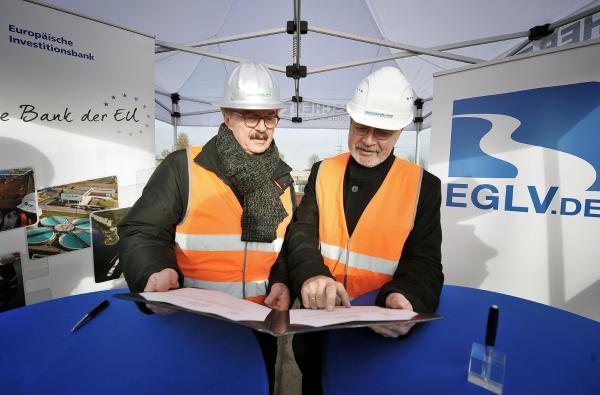
One of Germany’s largest environmental projects is continuing to receive support from the European Investment Bank (EIB). The EU’s promotional bank is providing an additional EUR 450m loan to Emschergenossenschaft for the comprehensive restructuring of the Emscher river system. Dr Werner Hoyer, President of the EIB, and Dr Jochen Stemplewski, Chairman of Emschergenossenschaft’s management board, signed the contract today in Bottrop.
With this loan, the EIB is co-financing Emschergenossenschaft’s investment programme for the period 2014 to 2016. Following an initial financing operation in 2011, this is the EIB's second contribution to this large-scale development project. The Bank is again advancing a loan for EUR 450m. In addition to the large loan amounts, the EIB can also offer highly attractive lending terms: the loan is once again for a period of 45 years and has a fixed interest rate despite the long maturity.
With more than five million inhabitants, the Ruhr area is Germany's largest conurbation and also the hub of Germany’s heavy industry. The Emscher River flows through the centre of the Ruhr area, a region with a population of almost 2.5 million. Mining, in particular, has had a decisive economic influence on the region, but not without significant repercussions on the landscape. As the construction of an underground sewerage system was ruled out by the subsidence caused by coal mining activities, the Emscher and its tributaries have been used for almost 100 years as an open sewerage system. Not until the mining industry moved to the north in the eighties was it possible to restructure the Emscher. By 2017, the new underground Emscher wastewater mains (ACE) will be installed at a depth of up to 40 m over a total distance of 51 km, from Dortmund-Deusen in the east of the Ruhr area to Emschermündung wastewater treatment plant in Dinslaken.
This major long-term project is accompanied by the environmental reconstruction of the river landscape. The Emscher is being restored to its natural state. Former industrial and derelict land is regaining its natural character. Important natural and recreational areas are thus being created in the densely populated region, which have already substantially improved the quality of life of the local inhabitants. This rehabilitation process is expected to be completed by 2020.
A recent study by the North Rhine-Westphalia Institute for Economic Research also indicates that the overall project is having a positive impact on employment: the Emscher rehabilitation project is safeguarding 3 700 jobs in the Region, including 1 400 directly through construction measures.
At the signing ceremony, Dr Werner Hoyer, President of the European Investment Bank, stated, “The Emscher rehabilitation project sets an example for the whole world. It clearly demonstrates for all to see how a region marked by industry over many decades can be transformed into a pleasant, nature-oriented landscape. In terms of its financial scope and timetable, it is also a particularly significant project for us. I am therefore extremely proud of the EIB’s involvement, which highlights the vital role that the EU bank plays in such crucial long-term development initiatives.”
Dr Jochen Stemplewski, Chairman of Emschergenossenschaft management board said, “Our Emscher rehabilitation project with an overall cost of EUR 4.5bn, involving 350 km of waterways is the largest European project to restore a complete river landscape and a driver of structural change. We are giving back to the people of the region their river and thereby enhancing their quality of life. The framework loan contract with the EIB supports this important project.”

Photographer: EIB ©Tim Foltin
Download original

Photographer: EIB ©Tim Foltin
Download original

Photographer: EIB ©Tim Foltin
Download original

©To be defined
Download original

©To be defined
Download original